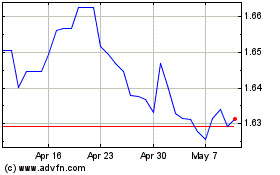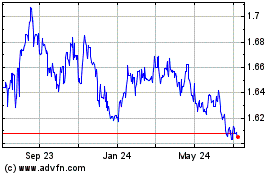Australia, NZ Dollars Fall
October 01 2015 - 9:19PM
RTTF2
The Australian and the New Zealand dollars weakened against
their major counterparts in the Asian session on Friday, as
regional investors are resorting to profit taking after recent
gains.
Meanwhile, commodity prices fell amid fears of a slowdown in
China and the uncertainty over the timing of the U.S. Federal
Reserve's interest rate hike.
China's manufacturing conditions deteriorated the most in
six-and-a-half years in September as orders declined sharply on
weak foreign demand, results of a private sector survey revealed
Thursday.
A Labor Department report showed first-time claims for U.S.
unemployment benefits to have increased more than expected in the
week ended September 26. Meanwhile, a report from the Institute for
Supply Management showed that activity in the U.S. manufacturing
sector dropped to a two-year low in September, partly reflecting
concerns about the global economy and customer confidence.
Traders await the U.S. employment data due later in the day to
get some clues on the possible timing of the first Fed rate
hike.
The report is expected to show an increase of about 203,000 jobs
in September following the addition of 173,000 jobs in August. The
jobs data could have a significant impact on expectations regarding
whether the Federal Reserve will raise interest rates later this
month.
Meanwhile, the Australian and the New Zealand dollars rose after
the release of Australian retail sales data but retreated shortly
after.
Data from the Australian Bureau of Statistics showed that the
total value of retail sales in Australia was up a seasonally
adjusted 0.4 percent on month in August, worth A$24.404
billion.That was in line with forecasts following the 0.1 percent
contraction in July.
In other economic news, data from ANZ showed that commodity
prices in New Zealand increased for the first time in six months in
September, driven by increases in dairy and aluminium prices. The
ANZ commodity prize index climbed 5.5 percent month-over-month in
September, reversing a 5.2 percent decrease in the previous
month.
Thursday, the Australian and the New Zealand dollars weakened
against their major rivals after the release of the Chinese
manufacturing data that was not as worse as feared. The Australian
dollar rose 0.66 percent against the U.S. dollar, 0.44 percent
against the yen and 0.30 percent against the euro. The NZ dollar
rose 0.67 percent against the U.S. dollar, 0.62 percent against the
yen and 0.14 percent against the euro.
In the Asian trading, the Australian dollar fell to an 8-day low
of 0.9283 against the Canadian dollar, from yesterday's closing
value of 0.9326. The aussie may test support near the 0.91
area.
The aussie dropped to 84.13 against the yen and 1.5957 against
the euro, from yesterday's closing quotes of 84.26 and 1.5916,
respectively. If the aussie extends its downtrend, it is likely to
find support around 82.00 against the yen and 1.63 against the
euro.
Against the U.S. and the New Zealand dollars, the aussie edged
down to 0.7018 and 1.0964 from yesterday's closing quotes of 0.7026
and 1.0976, respectively. On the downside, 0.68 against the
greenback and 1.08 against the kiwi are seen as the next support
levels for the aussie.
The NZ dollar fell to 2-day lows of 0.6384 against the U.S.
dollar and 1.7523 against the euro, from yesterday's closing quotes
of 0.6394 and 1.7491, respectively. If the kiwi extends its
downtrend, it is likely to find support around 0.62 against the
greenback and 1.80 against the euro.
Against the yen, the kiwi edged down to 76.59 from yesterday's
closing value of 76.69. The kiwi is likely to find support around
the 74.00 area.
Looking ahead, Markit/CIPS U.K. construction PMI for September
and Eurozone PPI for August are due to be released later in th
day.
In the New York session, U.S. jobs data for September and
factory orders for August are slated for release.
At 8:45 am ET, Federal Reserve Bank of Philadelphia President
Patrick Harker is scheduled to give opening remarks before the "New
Perspectives on Consumer Behavior in Credit and Payments Markets"
conference hosted by the Federal Reserve Bank of Philadelphia.
Half-an-hour later, Federal Reserve Bank of St. Louis President
James Bullard is expected to speak on the economy and monetary
policy before a Shadow Open Market Committee meeting hosted by the
Manhattan Institute for Policy Research, in New York.
At 1:30 pm ET, Federal Reserve Bank of Boston President Eric
Rosengren will give welcome and opening remarks before the "Macro
Prudential Monetary Policy" conference hosted by the Federal
Reserve Bank of Boston. Additionally, Federal Reserve Governor
Stanley Fischer is expected to speak at the conference.
Euro vs AUD (FX:EURAUD)
Forex Chart
From Mar 2024 to Apr 2024

Euro vs AUD (FX:EURAUD)
Forex Chart
From Apr 2023 to Apr 2024
